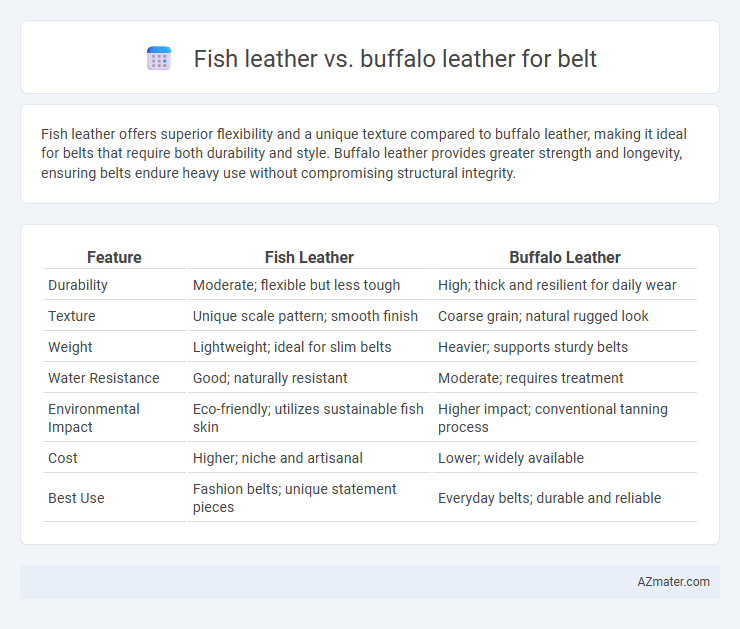Fish leather offers superior flexibility and a unique texture compared to buffalo leather, making it ideal for belts that require both durability and style. Buffalo leather provides greater strength and longevity, ensuring belts endure heavy use without compromising structural integrity.
Table of Comparison
| Feature | Fish Leather | Buffalo Leather |
|---|---|---|
| Durability | Moderate; flexible but less tough | High; thick and resilient for daily wear |
| Texture | Unique scale pattern; smooth finish | Coarse grain; natural rugged look |
| Weight | Lightweight; ideal for slim belts | Heavier; supports sturdy belts |
| Water Resistance | Good; naturally resistant | Moderate; requires treatment |
| Environmental Impact | Eco-friendly; utilizes sustainable fish skin | Higher impact; conventional tanning process |
| Cost | Higher; niche and artisanal | Lower; widely available |
| Best Use | Fashion belts; unique statement pieces | Everyday belts; durable and reliable |
Introduction to Fish Leather and Buffalo Leather
Fish leather, derived from sustainable fish skin such as salmon or perch, offers a unique texture and is notably thinner yet highly durable due to its dense fiber structure. Buffalo leather, sourced from buffalo hides, is renowned for its toughness, natural grain, and resistance to wear, making it a traditional choice for belts requiring long-lasting strength. Both materials provide distinct aesthetic and functional qualities, with fish leather prized for its eco-friendly appeal and intricate patterns, while buffalo leather is valued for robustness and classic leather characteristics.
Sourcing and Sustainability
Fish leather, sourced from byproducts of the fishing industry, offers a sustainable alternative by reducing waste and minimizing environmental impact, while buffalo leather typically relies on livestock farming which has higher carbon emissions and water usage. Fish leather's rapid renewable source and lower tanning chemical requirements contribute to its eco-friendly profile compared to traditional buffalo leather. Brands increasingly prefer fish leather for belts to meet consumer demand for sustainable fashion without compromising durability.
Processing and Craftsmanship
Fish leather, derived primarily from salmon, cod, or perch skins, undergoes a meticulous tanning process that preserves its distinctive scale patterns and flexibility, making it a lightweight and durable choice for belts. Buffalo leather, known for its robust grain and thickness, requires extended vegetable or chrome tanning to enhance its toughness and aging quality, producing a sturdier and more rugged belt option. Craftsmanship in fish leather belts demands delicate handling and precision to maintain the natural texture, while buffalo leather belts benefit from traditional techniques that emphasize strength and longevity.
Durability and Strength
Fish leather offers unique durability due to its dense fiber structure, making it resistant to stretching and wear, ideal for lightweight and flexible belts. Buffalo leather is renowned for its exceptional strength and toughness, providing superior resistance to abrasion and long-lasting durability in heavy-duty belts. When comparing durability and strength, buffalo leather generally surpasses fish leather, making it better suited for belts requiring maximum resilience.
Texture and Appearance
Fish leather offers a unique texture characterized by a natural scale pattern that provides a distinct, eye-catching appearance compared to the smooth, grainy texture of buffalo leather. Buffalo leather displays a rugged, matte finish with pronounced grain and durability, while fish leather tends to have a glossy, almost iridescent surface that enhances visual appeal. These textural differences make fish leather belts stand out with a more exotic look, whereas buffalo leather belts exude a classic, rustic elegance.
Comfort and Flexibility
Fish leather offers superior flexibility and softness compared to buffalo leather, making it ideal for belts that require comfortable wear and adaptability to wrist or waist movements. Buffalo leather tends to be thicker and stiffer, providing durability but often sacrificing immediate comfort and easy bending. The natural fibers in fish leather create a lightweight, breathable texture that enhances comfort during extended use.
Water Resistance and Maintenance
Fish leather offers superior water resistance compared to buffalo leather due to its dense, tightly-packed scales which naturally repel moisture, making it a durable choice for belts exposed to damp environments. Buffalo leather, while robust, is more porous and requires regular conditioning and waterproofing treatments to maintain its water resistance and prevent cracking. Maintenance for fish leather belts is minimal, typically involving gentle cleaning and occasional oiling, whereas buffalo leather demands consistent care to preserve its longevity and appearance under wet conditions.
Environmental Impact
Fish leather for belts offers a significantly lower environmental impact compared to buffalo leather, as it utilizes fish skin byproducts that would otherwise be discarded, reducing waste and promoting sustainability. The tanning process for fish leather often requires fewer chemicals and less water, minimizing pollution and resource consumption. Buffalo leather production typically involves higher greenhouse gas emissions, greater water usage, and deforestation concerns linked to cattle farming, making fish leather a more eco-friendly choice.
Price and Accessibility
Fish leather for belts tends to be more expensive due to its niche market and labor-intensive tanning process, making it less accessible compared to buffalo leather. Buffalo leather is widely available, benefiting from established supply chains and mass production, which results in lower prices and easier access for consumers. The price discrepancy reflects not only material scarcity but also the specialized craftsmanship involved in preparing fish leather.
Which Leather is Best for Belts?
Fish leather offers exceptional durability and unique texture, making it a sustainable and stylish option for belts, especially prized for its lightweight and water-resistant qualities. Buffalo leather provides superior toughness and a rugged appearance, favored for belts that require high wear resistance and a traditional aesthetic. Choosing the best leather for belts depends on desired durability, texture, and style, with fish leather excelling in eco-friendliness and distinctiveness, while buffalo leather leads in strength and classic appeal.

Infographic: Fish leather vs Buffalo leather for Belt
 azmater.com
azmater.com